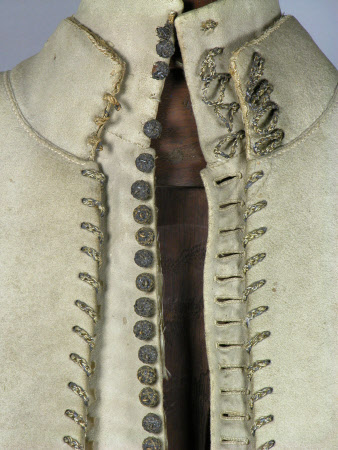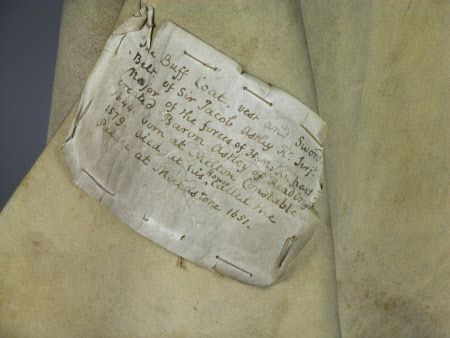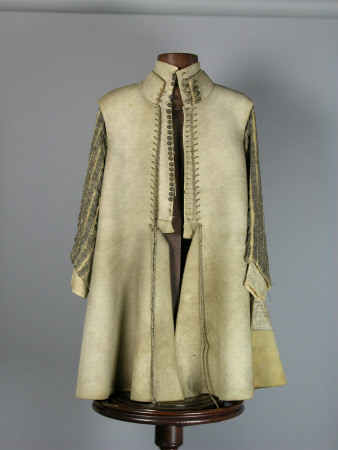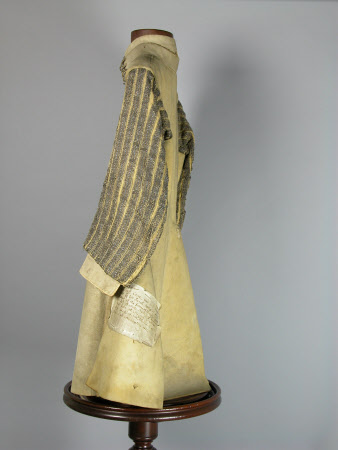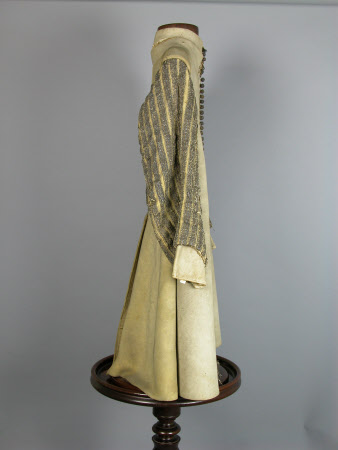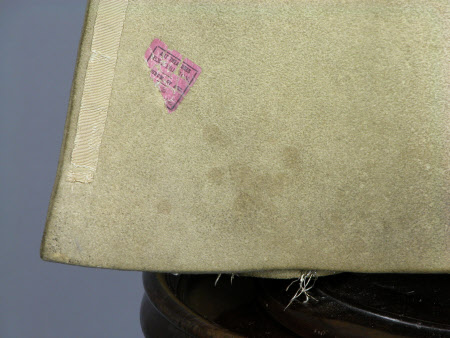Buff Coat
Category
Costume
Date
circa 1640 - 1646
Materials
Leather, gold and silver thread, silk
Measurements
800 x 420 mm; 40 mm (Height); 750 mm (Height); 60 mm (Height)
Order this imageCollection
Seaton Delaval Hall, Northumberland
NT 1276655.1
Summary
This buff coat and doublet once belonged to Sir Jacob Astley, 1st Baron Astley of Reading (1579-1652). The coat is made from four pieces of oil-tanned leather cut with wide skirts, topstitched together and reinforced with a double row of topstitching under the arms and at the sides. It has inset sleeves embellished with vertical stripes of gold and silver braid. The collar is finished with four silk and silver cord loops that once fastened to corresponding buttons (now lost). Silk and silver cord is stitched along both sides of the front opening ending with looped ties at the waist. Inside, the front panels are strengthened from the shoulder to the waist with a stiffened interlining and the main body lined with silk. Nine tabs have been added to the inside waist to allow fastening to breeches. Beneath the buff coat is an oil-tanned leather doublet with long sleeves each with a slit at the cuff and edged in silk, that reach beyond the cuffs of the buff coat above. The high collar is fastened by five cord loops and the three buttons (remaining from the original five). 19 buttons of silver and gold thread secure the front opening, corresponding to 22 buttonholes. The front of the doublet is reinforced and the whole garment lined with buff coloured silk. Ten tabs with metal rings intended to fasten to breeches are stitched at the inner waist. A paper label written in ink, is stitched to the right front of the buff coat and reads 'The Buff Coat, vest and Sword Belt of Sir Jacob Astley Kt: Serjt. Major of the forces of H:M:K: Chas:I. created Baron Astley of Reading 1644. born at Melton Constable 1579. died at his House called the Palace at Maidstone 1651.'. Adhered to the inside of the proper right skirt are the remains of a small pink paper label printed ‘Art Treasures Exhibition Museum of Art’.
Full description
Buff coats evolved from shorter buff jerkins (or waistcoats) worn in the 16th century, which were named after the tough oil-tanned buffalo leather they were made from (Dowden, 2015). They were favoured by Royalist and Parliamentarian forces of the British Civil Wars, and the nobility and officers of both sides were often shown wearing buff coats with metal breast plates in their portraits. This buff coat and doublet belonged to Royalist infantry commander, Sir Jacob Astley, 1st Baron Astley of Reading (1579-1652). In his portrait of 1640 (NT 1276843), Astley wears a similar buff coat with a high buttoned collar over a gold and silk brocade doublet and underneath a metal breastplate held in place with buckled leather straps. With long thigh or knee-length skirts, buff coats of cattle or deer hide became popular battle attire for the elite as the leather was lighter and more flexible to wear than full armour and could withstand musket shot at long range (Reynolds, 2013). Sir Jacob Astley was the eighth child of Isaac Astley (1540 – 1598) of Melton Constable, Norfolk, and Mary Waldegrave (1579 – 1645), daughter of Edward Waldegrave of Lawford, Essex. Destined for a military career, Astley joined Sir Walter Raleigh’s Azores expedition of 1597 when he was still a teenager. He went on to work as a mercenary in Europe, serving at significant battles such as the Battle of Nieuwpoort in 1600 fought between Anglo-Dutch and Spanish forces, and eventually married a Dutch heiress, Agnes Impel (d.1652) sometime before 1619. Returning to England in the 1630s, he was appointed sergeant-major-general under Charles I (1600-1649) during the bishops’ wars fought against Scotland in 1639 and 1640. At the outbreak of war in 1642, Astley again received a commission as sergeant-major-general from the king (Roy, 2004). History tells that Astley wore this buff coat and doublet at the Battle of Edgehill on the 23rd October 1642. As he led an infantry arm of 10,000 men into battle, he delivered a prayer before the onset of fighting that was to become famous: ‘O Lord! Thou knowest how busy I must be this day; if I forget thee, do not thou forget me … March on, boys!’. Astley’s importance to the Royalist forces increased throughout the war and he was appointed, amongst other posts, as governor of Oxford and a leading member of the Kings Council of War. He also saw action at Reading, Gloucester and Lostwithiel, but his infantry were forced to surrender during the final major battle of the war in 1645 at Naseby. Astley escaped, only to be defeated again at Stow-in-the-Wold in 1646, whilst on his way to the besieged King at Oxford. He was created Baron Astley of Reading in 1644. Sir Jacob Astley’s portrait (NT 1276843) is entered as object 148 in the catalogue Art Treasures Exhibition, Manchester, 1857 which reads: "Sir Jacob Astley (first Lord Astley), Major-General of the Foot to Charles I. In armour and buff. Inscribed 'Aetat 67, Anno Doi 1640'. The breast-plate, buff coat, and sword of Sir Jacob Astley are in the Exhibition." They were lent by Lord Hastings (JNM, 2021).
References
Dowen 2015: Keith Dowden, 'The Seventeenth Century Buff Coat', Journal of the Arms and Armour Society (2015): 157-188 Roy 2004 Ian Roy, ‘Astley, Jacob, first Baron Astley of Reading (1579–1652), royalist army officer’, Oxford Dictionary of National Biography, 23 September 2004 https://www.oxforddnb.com/view/10.1093/ref:odnb/9780198614128.001.0001/odnb-9780198614128-e-817
